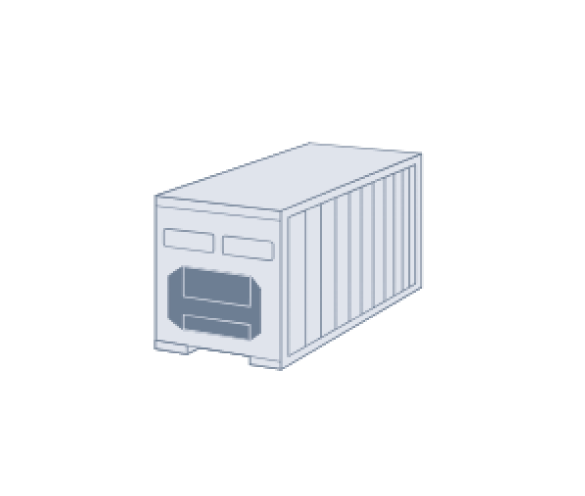20′ REFRIGERATED

INSIDE LENGTH:
INSIDE WIDTH:
INSIDE HEIGHT:
DOOR WIDTH:
DOOR HEIGHT:
CAPACITY:
TARE WEIGHT:
MAX CARGO WEIGHT:
5.724 m
2.286 m
2.014 m
2.286 m
2.067 m
26 m3
2550 Kgs
21450 Kgs
Description
The refrigeration unit is arranged in such a way that the external dimensions of the container meet ISO standards and thus fit into the container ship cell guides, for example. The presence of an integral refrigeration unit entails a loss of internal volume and payload.
When being transported by ship, integral units have to be connected to the on-board power supply system. The number of refrigerated containers which may be connected depends on the capacity of the ship\’s power supply system. If the aforesaid capacity is too low for the refrigerated containers to be transported, “power packs” may be used, which are equipped with relatively large diesel generators and satisfy ISO requirements with regard to the dimensions of a 20\’ container. When at the terminal, the containers are connected to the terminal\’s power supply system. For transport by road and rail, most integral unit refrigeration units are operated by a generator set (genset). This may either be a component of the refrigeration unit or connected to the refrigeration unit.
Air flows through the container from bottom to top. In general, the “warm” air is drawn off from the inside of the container, cooled in the refrigeration unit and then blown back in the container as cold air.
To ensure adequate circulation of the cold air, the floor is provided with gratings. Pallets form an additional space between container floor and cargo, so also forming a satisfactory air flow channel. In addition, the side walls of the container are “corrugated”, which ensures satisfactory air flow there too.
In the upper area of the container, adequate space (at least 12 cm) must likewise be provided for air flow. For this purpose, during packing of the container adequate free space must be left above the cargo. The maximum load height is marked on the side walls.
To ensure vertical air flow from bottom to top, packaging must also be appropriately designed and the cargo must be sensibly stowed.
In addition to temperature regulation, integral units also allow a controlled fresh air exchange, for example for the removal of metabolic products such as CO2 and ethylene in the case of the transport of fruits.
In the refrigeration units, both the supply and return air temperatures are measured and, depending on the operating mode, one of these values is used to control the cold air. Temperature measurement may be performed in various ways. The Partlow recorder generally records return air temperature, since this provides an indication of the state or temperature of the cargo. Data loggers are increasingly used, which detect temperature digitally and indicate it on a display. Once transferred to a PC, the data may then be evaluated.
The temperature display is attached to the outside of the refrigeration unit, so that operation of the unit may be checked at any time.
Digital or analog recorders may also be positioned directly in the cargo, so as to measure temperatures inside the container. The recorder should be accommodated in such a way that it records the temperatures at risk points in the container (inside the packaging, top layer at door end).
Integral units may be stowed both above and below deck on a ship. Above deck stowage has the advantage that the heat from return air may be more readily dissipated. However, the containers are often exposed to strong solar radiation, leading to increased refrigeration capacity requirements.
Usage
Refrigerated containers are used for goods which need to be transported at a constant temperature above or below freezing point. These goods are divided into chilled goods and frozen goods, depending on the specified transport temperature. They principally include fruit, vegetables, meat and dairy products, such as butter and cheese.
High-cube integral units are used in particular for voluminous and light goods (e.g. fruit, flowers).
Nowadays, goods requiring refrigeration are mostly transported in integral units, which have a markedly higher market share than porthole containers.
Chilled meat is sometimes also transported hanging, for which purpose the ceilings of refrigerated containers are equipped with special hook rails
